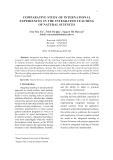
52
Introduction
In recent years, an increasing number of students from developed countries have
opted to study in less developed nations for a semester, a year, or even their entire
academic program. This shift marks a significant departure from traditional study-abroad
patterns, where students primarily sought education in established Western institutions.
The increasing mobility toward non-traditional destinations, including countries in Asia,
Africa, and Latin America, reflects a broader transformation in global higher education.
This shift is driven by several key factors. First, cultural immersion and global competency
have become essential components of modern education, with students seeking first-hand
exposure to diverse cultures, languages, and historical contexts. Second, cost-effectiveness
plays a crucial role, as the high cost of tuition and living expenses in many Western countries
has led students to explore affordable yet high-quality alternatives. Additionally, certain
developing nations offer unique research opportunities, particularly in fields such as
environmental science, international development, and regional studies, allowing students
to engage with pressing global challenges in a more direct and meaningful way. In Asia,
China is steadily emerging as a prominent destination for higher education, particularly
attracting students from developing countries and neighboring Asian nations (Wen et al.,
2018).
Vietnam has potential to capitalize on this trend by strengthening its appeal as a
study-abroad destination. This paper examines the benefits of hosting international
students, including economic, academic, and cultural advantages. Furthermore, it outlines
practical strategies to increase Vietnam’s attractiveness to international students, drawing
insights from existing literature on higher education in some developing countries in Asia.
By enhancing the quality of higher education, improving support services for international
students, and strategically promoting its academic institutions on the global stage, Vietnam
can attract a greater number of students from diverse backgrounds.
First, I provide an overview of the growing trend of studying abroad among students
from the United States and European countries, highlighting key patterns and motivations
driving international student mobility in section one. Next, I review the benefits of hosting
international students, in terms of the economic, academic, and cultural advantages that
international students bring to host countries and institutions, drawing on existing studies
in the field of international education. In part three, I analyze specific strategies Vietnam
can adopt to attract more international students. This analysis identifies Vietnam’s unique
advantages as a study-abroad destination and explores lessons from policies and practices
implemented in China and other Asian countries that have successfully increased their
share of international students. These insights offer practical recommendations for Vietnam
to strengthen its global position in higher education.































